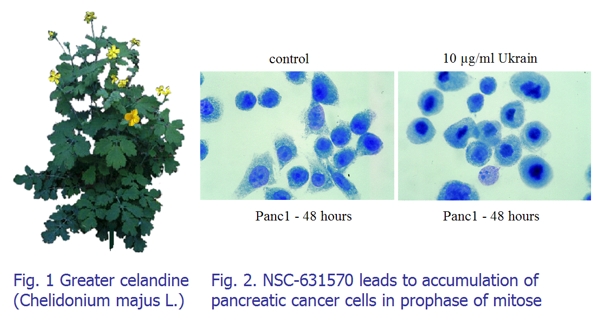W. Nowicky, A. Nowicky, B. Nowicky, J. Hodisch, Ukrainian Anticancer Institute, Vienna, Austria
First indications on the selective effect of NSC 631570 on the cancer cells were provided in an early study when different oxygen consumption by normal liver cells and Ehrlich’s tumor ascitic cells after the incubation with NSC 631570 was revealed.
In the tests on the Jurkat lymphoma model, NSC 631570 has been proven to be a strong apoptosis inductor. Profound research showed NSC 631570 brought about the depolarisation of mitochondrial membranes and consequently the activation of caspases.
Ukrain induced apoptosis in a panel of cancer cell lines (cervical cancer HeLa, HeKB, HeKS32, HeBcl3, HeNFR and HeIKK, human colon cancer SW480, human renal carcinoma HEK293, human osteosarcoma MG-63) by activating the caspases of the intrinsic cell death pathway. Interestingly, non-transformed fibroblasts (hTERT) cell line was insensitive to the drug (255). In the tests on human cervix carcinoma cells HeLa, squamous carcinoma cells WHCO5, normal kidney cell line Graham 293, and transformed kidney cell line Vero from African green monkey, NSC 631570 inhibited the tubulin polymerisation and caused a metaphase block in cancer cells which is characterised by abnormal chromosomal distribution, and results in the formation of micronuclei and in apoptosis.

The effects of NSC 631570 on cell survival, alteration of the cell cycle and induction of apoptosis without and in combination with ionising radiation (IR) were investigated on the exponentially growing human tumor cells MDA-MB-231 (breast), PA-TU-8902 (pancreas), CCL-221 (colon), U-138MG (glioblastoma), and human skin and lung fibroblasts HSF1, HSF2 and CCD32-LU. Without IR, NSC 631570 exerted a time- and dose-dependant cytotoxic effect, more pronounced against the cancer cells. The combination of NSC 631570 plus IR enhanced toxicity in CCL-221 and U-138MG cells with their accumulation in the G2/M phase, but not in MDA-MB-231 and PA-TU-8902 cells. A radio protective effect was found in normal human fibroblasts. NSC 631570 caused the accumulation of prostate cancer cells as well as epidermoid carcinoma cells in the G2/M phase, however, not of normal cells.
The cytotoxic effects of NSC 631570 were evaluated in primary pancreatic cancer cell lines (PPTCC), fibroblasts derived from pancreatic ductal adenocarcinoma specimens (F-PDAC), and an immortalized epithelial ductal pancreatic cell line HPNE. Cytotoxic effects of NSC 631570 in PPTCCs were significantly higher than those observed in F-PDAC and HPNE cells. Furthermore, it was revealed that PPTCCs cells consumed more drug than F-PDAC and HPNE cells. This selective effect of Ukrain in PPTCCs may be related to a different transport system or higher metabolism of the drug in PDAC.
Altogether, in comparative studies NSC 631570 has been tested on 18 cancer and 12 benign cell lines at identical conditions so far. In all these experiments the selective effect of NSC 631570 against cancer cells was confirmed. This selective effect of NSC 631570 against cancer cells explains its good tolerability in clinical use.
|
Year
|
Autor
|
Mechanism
|
Method
|
Used cell
cancer
|
lines
non-cancer
|
|
1983
|
Brüller
|
Oxygen consumption
|
Measurement of oxygen consumption
|
Ehrlich mouse ascites tumor cells
|
Guinea pig liver homogenate
|
|
1992
|
Hohenwarter
|
Uptake
|
Cell growth inhibition, fluorescence microscopy
|
Human osteosarcoma and melanoma
|
normal endothelial cells
|
|
1998
|
Panzer
|
Metaphase block, anomal chromosome distribution, apoptosis
|
Spectrophotometrical analysis of DNA content, flow cytometry, cell morphology, cell cycle phases
|
Human cervix carcinoma cell line HeLa, squamous cell carcinoma WHCO5
|
normal equine lung cell line
|
|
2000
|
Ramadani
|
Apoptosis, cell cycle phases
|
Cell cycle analysis, proliferation assay,
Western blotting, Giemsa staining with following mitose sub-phase analysis Fluorescence immunostaining In-vitro polymerisation of monomeric tubulin |
Pancreas carzinoma cell lines AsPC1, BxPC3, MiaPaCa2, THP-1, and Jurkat
|
White blood cells
|
|
2000
|
Roublevskaya
|
Cyclin A, B1, CDK1, CDK2
|
Flow cytometric cell cycle analysis
Gel electrophoretic analysis of DNA Western blotting
|
Human epidermoid cancer cell lines A431, ME180
|
Primary human keratinocytes
|
|
2000
|
Panzer
|
Inhibition of the tubulin polymerisation
|
Cell growth studies
Indirect immunofluorescence Flow cytometric cell cycle analysis Tubulin polymerisation assay Cell morphology
|
HeLa (human cervical carcinoma), WHCO5 (human squamous cancer);
Transformed cell lines Graham 293 (transformed human kidney), Vero (transformed African green monkey kidney) |
Hs27 (human skin fibroblast), normal monkey kidney cells
|
|
2002
|
Cordes
|
Cell cycle phases, TP53, p21
|
Combined with irradiation
Cell growth
Flow cytometry
Protein extraction with spectral photometry (TP53) Western blotting
Flow cytometric analysis of apoptosis by annexin-V staining |
Human cancer cells:MDA-MB-231 (breast), PA-TU-8902 (pancreas), CCL-221 (colorectal), U-138MG (glioblastoma)
|
Human fibroblasts HSF1, HSF2 (skin), CCD32-LU (lung)
|
|
2006
|
Mendoza
|
Apoptosis (intrinsic pathway), mitochondria, caspases
|
Cellular viability, nuclear staining
Western blotting
Gene reporter analysis
|
HeLa cells in various modifications: HeKB, HeKS32, HeBcl3, HeNFR and HeIKK, colon cancer SW480,
Human renal carcinoma HEK293, human osteosarcoma MG-63 |
Human fibroblasts hTERT
|
|
2010
|
Funel
|
Uptake
|
Cytotoxity detection
Uptake by fluorescence
|
Primary pancreatic cancer cell lines
|
Fibroblasts derived from PDAC, immortalized epithelial ductal pancreatic cell line HNPE
|
References.
Roublevskaia IN, Polevoda BV, Ludlow JW, Haake AR. Induced G2/M arrest and apoptosis in human epidermoid carcinoma cell lines by semisynthetic drug Ukrain. Anticancer Res. 2000 Sep-Oct;20(5A):3163-7.
Cordes N, Plasswilm L, Bamber M, Rodemann HP. Ukrain®, an alkaloid thiophosphoric acid derivative of Chelidonium majus L. protects human fibroblasts but not human tumour cells in vitro against ionizing radiation. Int J Radiat Biol 2002, vol. 78, No. 1, 17-27.
Gagliano N, Moscheni C, Torri C, Magnani I, Bertelli A, Nowickz W, Gioia M. Effect of Ukrain on matrix metalloproteinase-2 and Secreted Protein Acidic and Rich in Cysteine (SPARC) expression in human glioblastoma cells. Anti-Cancer Drugs 2006, 17:189-194.
